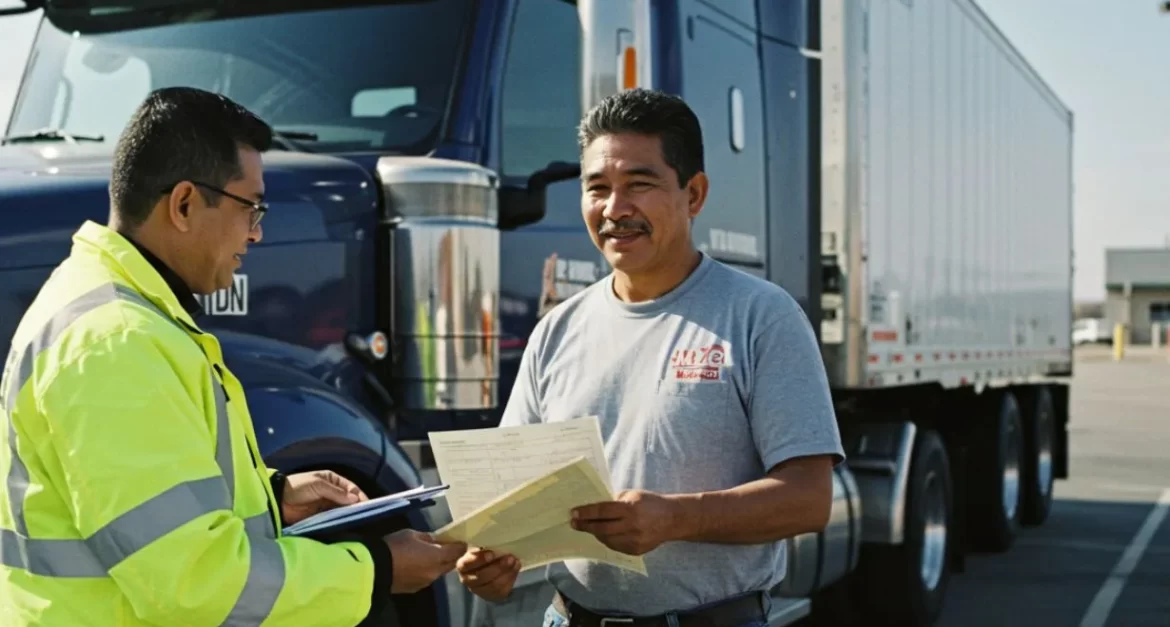
Have no time to read the entire article? How about listening to our episode? Follow us on Spotify for more valuable content:
Hey there, road warriors! If you’re an Owner Operator in the trucking world, the open road is your office. But with that freedom comes responsibility, and a big part of that is navigating DOT inspections. Seeing those flashing lights can be unnerving, but with knowledge and preparation, these inspections can be a minor checkpoint, not a major roadblock.
Commercial motor vehicle (CMV) safety is paramount. The U.S. Department of Transportation (DOT), mainly through its Federal Motor Carrier Safety Administration (FMCSA), enforces safety regulations. A key component is the DOT inspection program—systematic checks to ensure CMVs and drivers meet federal standards. For an Owner Operator, understanding these inspections isn’t just about avoiding fines; it’s crucial for a safe, viable business, especially with over three million roadside inspection violations recorded annually in the U.S.
Why Compliance is King for the Owner Operator
Adherence to DOT regulations is more than a legal chore. For an Owner Operator, compliance directly impacts operational efficiency, reputation, insurance costs, and the ability to secure loads. A strong compliance record is a competitive edge; violations mean increased scrutiny, higher costs, and potentially ceasing operations. Proactive compliance is an investment in your business’s future.
The link between safety, legality, and business viability is clear. A safety violation, like faulty brakes, is a legal issue that can lead to an Out-of-Service (OOS) order, halting revenue. It also negatively impacts your Compliance, Safety, Accountability (CSA) score. A poor CSA score can result in higher insurance premiums, difficulty securing loads, and more frequent inspections. This cycle shows how one lapse can undermine your business.
Understanding that inspections aim to enhance safety for everyone changes perspective. Hours of Service (HOS) rules prevent fatigue, and vehicle maintenance standards ensure mechanical safety. Internalizing this safety rationale shifts compliance from reluctant rule-following to an ingrained safety culture.


Deep Dive: The Three Main Flavors of DOT Inspections
The Commercial Vehicle Safety Alliance (CVSA) outlines eight inspection levels, but drivers most frequently encounter three during roadside stops or at weigh stations: Level I, Level II, and the Level 3 Inspection.
Level I: The North American Standard Inspection (The Full Monty)
The Level I inspection is the most comprehensive examination, assessing both driver qualifications and the vehicle’s mechanical condition.
Driver Aspects Checked:
- Commercial Driver’s License (CDL): Valid for vehicle class, with necessary endorsements.
- Medical Examiner’s Certificate & SPE Certificate: Current medical card and Skill Performance Evaluation Certificate, if applicable.
- Hours of Service (HOS) Compliance: Review of Record of Duty Status (RODS), typically via Electronic Logging Device (ELD). Clean HOS logs are vital.
- Drug or Alcohol Use: Observation for impairment.
- Seatbelt Usage: Confirmation of seatbelt use.
- Vehicle Inspection Reports (DVIRs): Review of daily reports.
- Carrier Identification and Status: Verification of motor carrier identity.
- Hazardous Materials (HM/DG) Docs (if applicable): Endorsements, shipping papers, placarding.
Vehicle Aspects Checked:
- Brake Systems: Detailed check of brakes, including air lines, chambers, slack adjusters, and pushrod travel.
- Tires, Wheels, Rims, and Hubs: Proper inflation, tread depth, condition of tires, wheels, rims, and hubs.
- Lighting Systems: All required lights operational.
- Steering Mechanism: Check for looseness, wear, or damage.
- Suspension System: Inspection of springs, airbags, etc.
- Fuel and Exhaust Systems: Checks for leaks and secure mounting.
- Cargo Securement: Proper blocking, bracing, and tie-downs.
- Coupling Devices: Fifth wheels, pintle hooks.
- Frame, Driveline/Driveshaft, Van/Open-Top Trailer Bodies: Structural integrity.
- Windshield Wipers: Proper operation.
- Emergency Equipment: Presence and serviceability of mandated equipment.
- Passenger Vehicles (Buses): Additional checks like emergency exits.
The Level I’s thoroughness means even minor issues can be cited. “Mostly compliant” often isn’t enough.
Level II: The Walk-Around Driver/Vehicle Inspection (The “What You See is What You Get”)
The Level II inspection covers many Level I items, but the inspector doesn’t go under the vehicle. It’s a visual and operational check of accessible components, including an under-hood look.
Driver Aspects Checked: Same as Level I (CDL, medical card, HOS, drug/alcohol, seatbelt, DVIRs, HM/DG).
Vehicle Aspects Checked: Items from Level I visible without going underneath (lights, tires, wipers, visible brake components, cargo securement).
Level III: Driver/Credential/Administrative Inspection (The Paperwork Deep Dive)
A Level 3 Inspection focuses exclusively on the driver’s credentials and documentation. The vehicle’s mechanical condition isn’t reviewed. This highlights that a mechanically sound truck can still incur violations if paperwork is amiss.
Driver Aspects Checked:
- CDL and Endorsements
- Medical Examiner’s Certificate and SPE Certificate
- HOS Logs/RODS
- Seat Belt Usage
- Vehicle Inspection Report(s) (DVIRs)
- Carrier Identification and Status
- HM/DG Requirements/Permits (if applicable)
- Use of Alcohol and/or Drugs
- Traffic Violations/Infractions
The “paperwork first” nature of a Level 3 Inspection means neglecting HOS logs, medical certificates, or other driver documents makes an Owner Operator vulnerable, even with a well-maintained truck.
While some inspections are random, many are initiated by an observable issue (e.g., a non-functioning light, speeding). A carrier’s CSA score also influences inspection likelihood; poorer scores mean more scrutiny. Maintaining a visibly well-kept vehicle, adhering to traffic laws, and managing a good safety record can proactively reduce inspection chances.
At-a-Glance: Comparing the DOT Inspection Levels
This table summarizes the key aspects:
Comparison of Key DOT Inspection Levels
| Inspection Level | Driver Aspects Checked | Vehicle Aspects Checked | Primary Focus |
|---|---|---|---|
| Level I: North American Standard Inspection | CDL, Medical Certificate/SPE, HOS/RODS, Drug/Alcohol Use, Seatbelt, DVIRs, Carrier ID, HM/DG (if applicable) | Comprehensive: Brakes (under-vehicle), Tires/Wheels, Lights, Steering, Suspension, Fuel/Exhaust, Cargo Securement, Coupling Devices, Frame, Driveline, Wipers, Emergency Equipment, etc. | Most thorough examination of both driver and vehicle. |
| Level II: Walk-Around Driver/Vehicle Inspection | CDL, Medical Certificate/SPE, HOS/RODS, Drug/Alcohol Use, Seatbelt, DVIRs, Carrier ID, HM/DG (if applicable) | All items from Level I that are visible/accessible without the inspector going under the vehicle (e.g., lights, tires, wipers, visible brake components, cargo securement). Includes under-hood check. | Comprehensive driver check and extensive vehicle check of accessible components. |
| Level III: Driver/Credential/Administrative Inspection | CDL, Medical Certificate/SPE, HOS/RODS, Drug/Alcohol Use, Seatbelt, DVIRs, Carrier ID, HM/DG (if applicable), Traffic Violations | None. Vehicle is not mechanically inspected. | Solely driver qualifications, documentation, and administrative compliance. |
Gearing Up: DOT Inspection Prep for the Savvy Owner-Operator
Thorough preparation is key. For an Owner Operator, this means meticulous attention to driver qualifications, vehicle condition, documentation, and business compliance.
Driver Readiness: Your Personal Compliance Arsenal
- Flawless Driver Qualification File (DQF): If under your own authority, maintain a DQF for yourself and any employed drivers, including application, MVR, CDL copy, drug/alcohol test results, medical certificate, and prior employment safety checks. Retain for three years.
- Valid CDL, Medical Certificate, and Endorsements: Ensure your CDL is current, correct class, with all endorsements. Carry your current Medical Examiner’s Certificate.
- Mastering Hours of Service (HOS) and ELD Compliance: Strictly adhere to HOS limits. Most CMVs require ELDs; understand yours and any exemptions. Accurate logging is crucial; “failing to record duty status” and “false reports” are serious violations. Present RODS for the previous seven days upon request. Keep ELD data for six months and the user manual in the truck.
- Drug and Alcohol Program Compliance: Owner-operators under their own authority must join a DOT Drug & Alcohol Testing Program consortium. Understand pre-employment, random, post-accident, and reasonable suspicion testing. FMCSA Clearinghouse registration is mandatory.
Impeccable driver paperwork is a critical first defense against deeper investigation.
Vehicle Readiness: Keeping Your Rig Road-Safe and Ready
- The Cornerstone: Pre-Trip and Post-Trip Inspections:
- Pre-Trip: Before each trip, inspect the vehicle, verify cargo securement, and review the last DVIR, ensuring any noted deficiencies are repaired. Allow 15-20 minutes.
- Post-Trip: At day’s end, inspect and document defects on a DVIR. Address safety-affecting defects before reuse.
- Proactive Vehicle Maintenance Schedule: Implement a regular schedule for key systems like brakes, tires, lights, and steering. Vehicle maintenance violations are common. Keep detailed repair records. Preventive maintenance is often more economical than facing fines and OOS downtime.
- Driver Vehicle Inspection Reports (DVIRs): Consistently completed DVIRs are vital. Retain post-trip inspection records noting defects for at least 90 days.
- Essential Emergency Equipment: CMVs must carry:
- Fire Extinguisher: Properly rated (e.g., 5 B:C for non-hazmat), securely mounted, accessible, and inspected.
- Spare Fuses: At least one for each type/size needed.
- Warning Devices: Three bidirectional reflective triangles, OR six fusees, OR three liquid-burning flares.
Emergency Equipment Checklist:
Required Emergency Equipment Checklist
| Equipment Item | FMCSA Requirement/Specification | Checked? (Y/N) |
|---|---|---|
| Fire Extinguisher |
Non-Hazmat: Min. 5 B:C rating OR two min. 4 B:C rated.
Placarded Hazmat: Min. 10 B:C rating. Securely mounted, accessible, inspected. |
|
| Spare Fuses | At least one spare for each type/size used in the vehicle's essential circuits. | |
| Warning Devices |
EITHER: Three (3) bidirectional emergency reflective triangles (meeting FMVSS 571.125).
OR: At least six (6) fusees. OR: At least three (3) liquid-burning flares. |
(While not explicitly mandated by 49 CFR 393.95, carrying a well-stocked first aid kit and a high-visibility reflective vest is a highly recommended best practice for driver safety.)
Common DOT Violations to Watch Out For
Vehicle-Related: Issues with Brakes (adjustment, components, leaks), Lights (inoperative), Tires (tread depth, damage, inflation), Cargo Securement, Fluid Leaks, missing Proof of Annual Inspection.
Driver-Related: HOS violations (exceeding limits, false logs), CDL Issues (invalid, wrong class, no endorsements), Medical Certificate problems (missing, expired), Failed Drug Test.
Paperwork/Administrative: Missing/incomplete documents (registration, insurance, permits), Hazardous Materials paperwork errors.
(Refer to the detailed “Common DOT Violations and How to Avoid Them” table in the previous, longer version or source document for specific examples and preventative actions.)
The Sting: Consequences of Violations
- Fines: Can range from hundreds to tens of thousands of dollars.
- Out-of-Service (OOS) Orders: For critical violations, halting operations until corrected. OOS time is financially impactful.
- Impact on CSA Scores: Violations contribute to CSA scores. Higher (poorer) scores lead to more inspections, increased insurance, and difficulty securing business.
- License Suspension/Revocation of Operating Authority: For severe or repeated violations.
- Reputational Damage: A poor compliance record harms industry standing.
Even minor, unaddressed violations accumulate and negatively impact CSA scores.
Conclusion: Building a Culture of Safety and Success – One Mile at a Time
For Owner Operators, proactive and thorough preparation for DOT inspections is essential. Understand the inspection levels (Level I, Level II, Level 3 Inspection), and maintain meticulous attention to driver qualifications, vehicle readiness (including brakes, tires, and emergency equipment), HOS adherence, drug and alcohol program participation, and complete documentation.
The long-term benefits of a proactive compliance culture are significant: enhanced safety, improved CSA scores (leading to lower insurance and better freight access), reduced disruptions, and greater peace of mind. Compliance is an ongoing commitment. Stay informed about evolving FMCSA rules. By prioritizing safety and compliance, Owner Operators build resilient, reputable, and profitable businesses.
Stay safe out there!